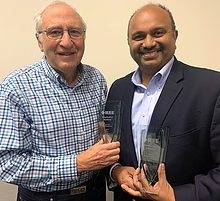 Two University of Maryland faculty members have been inducted into the IEEE Visualization Academy, considered the highest and most prestigious honor in the field of computer visualization.
Two University of Maryland faculty members have been inducted into the IEEE Visualization Academy, considered the highest and most prestigious honor in the field of computer visualization.
Ben Shneiderman (left in photo), distinguished university professor emeritus, and Amitabh Varshney (right), professor and dean of the College of Computer, Mathematical, and Natural Sciences, were recognized for their work in human-computer interaction and high-performance computer graphics and visualization, respectively.
The two Maryland faculty join 30 other researchers named to the inaugural cohort of the Vis Academy, established in 2019 to recognize significant accomplishments by researchers in computer visualization who directly bolster the endeavors of the entire field.
Shneiderman, Varshney and the other selected candidates were officially inducted into the academy on Oct. 22 at the VIS 2019 conference in Vancouver, British Columbia.
“We consider these researchers to be the best of the best and expect many of them continue to advance the field of visualization through their technical leadership, the mentoring and fostering of new talent, and other community services,” says Arie Kaufman, distinguished professor of computer science at Stony Brook University who chaired the IEEE Visualization Academy selection committee.
Shneiderman and Varshney, in addition to their academic tenure home in computer science, have appointments in the University of Maryland Institute for Advanced Computer Studies (UMIACS). Varshney previously served as director of the institute for almost seven years.
“Ben and Amitabh both embody the philosophy and spirit of our research institute’s core mission—using powerful computing tools to make a positive impact on both science and society,” says Mihai Pop, professor of computer science and current director of UMIACS. “We could not be prouder that they are being recognized with such an honor.”
Shneiderman came to the University of Maryland in 1976, and several years later became founding director of the university’s Human-Computer Interaction Lab. His early work in treemaps—a method of visually displaying complex sets of data using rectangular shapes—led to hundreds of papers that refined and applied this basic idea.
Much of Shneiderman’s research has focused on finding the most efficient and user-friendly strategies for humans to use computers, particularly in making them more visually and graphically appealing.
Shneiderman credits much of his productivity and impact to his students, and a more than 25-year collaboration with UMIACS senior research scientist Catherine Plaisant.
His recent work with Plaisant and others continues to advance discoveries in electronic health records, network visualization and science policy.
A member of the National Academy of Engineering, National Academy of Inventors, and fellow of the IEEE, American Association for the Advancement of Science, and Association for Computing Machinery (ACM), Shneiderman has received numerous awards while at Maryland, including the ACM SIGCHI Lifetime Achievement Award, IEEE Career Visualization Award, National Federation of Advanced Information Services Miles Conrad Lecture Award and ACM SIGCAS’s Making a Difference Award.
Go here to see a video overview of Shneiderman’s pioneering research and scholarship in human-computer interaction and information visualization.
Varshney, who came to Maryland in 2000, is a noted researcher and educator with extensive experience forming multidisciplinary groups to address significant scientific and societal challenges.
His work explores applications of high-performance computer graphics and visualization in science, engineering, medicine and the arts. His research also involves virtual and augmented reality, an expanding field that could revolutionize education, health care, public safety, and the visual and performing arts.
He taught the university’s first undergraduate course in virtual and augmented reality in 2016, and spearheaded a campus-wide effort to launch a new undergraduate major in immersive media design, expected to launch in fall 2020.
Varshney’s research findings are being used in many fields, including climate modeling, plasma physics, nanomanufacturing, architecture and industrial engineering, medical imaging, gene sequencing, and the creative arts.
Through MPowering the State—a strategic partnership between the University of Maryland, College Park, and the University of Maryland, Baltimore—Varshney helped bring together scientists and clinicians from both institutions to launch the Maryland Blended Reality Center.
The center joins critical care specialists from the University of Maryland School of Medicine with computing experts in College Park. Together, they are developing new virtual and augmented reality-based tools that address four high-impact areas: critical-care patient diagnostics, human anatomy education, non-opioid pain management and implicit bias training.
Varshney is an elected fellow of IEEE and a recipient of the IEEE Technical Achievement Award and a National Science Foundation Faculty Early Career Development Award. He is also a director of the IEEE Visualization and Graphics Technical Committee.
Go here to see a video of Varshney’s collaborative work with physicians at the renowned R Adams Cowley Shock Trauma Center in Baltimore. And go here to view one of Varshney’s latest projects—combining powerful visualization tools with the performing arts to transform the way that people can experience classical music.